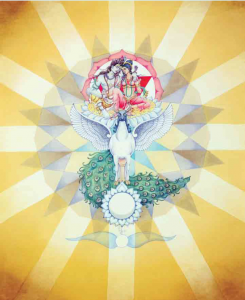
As a young man Harish Johari, a jnana yogi and aryuvedic practitioner who was the principal teacher about the chakras for all three authors, gave up his job as manager of a factory to become a yogi and artist. He did the murals on the walls of temples in northern India, created small paintings as well, and was also a sculptor. When he resigned as manager of the factory, his father told him he would have to gain a very broad and deep education “because an artist has to know everything.”
Johari developed a unique wash method of painting that involves many layers on top of each other, with a wash of an underlying layer before proceeding to the next one. He left behind a rich collection of his own paintings and drawings, and taught drawing and painting in India, Europe, and America. All three authors took his art classes, which required very precise geometrical measurements and also great creativity.
Just one of the three of us displayed a special talent for the work. That was Pieter Weltevrede from the Netherlands, who became Johari’s principal art student. Inspired by the master, he made painting his own life work. To date he has created hundreds of paintings. Some can be found in the center color section of Awakening the Chakras. These include a yantra (the visual equivalent of a mantra) for each of the seven chakras and two extra paintings for the seventh chakra, and also several other works. In the book he has also included a black-and-white line drawing of each painting in which it is easy to see the details of both the principal figures and the smaller symbols. This is followed by his explanation in the text of the traditional meaning of each one of these. ( Johari used to take Pieter to museums in India and point out what each of the symbols in the paintings and sculptures meant.) Victor comments, “I used to look at the classsical art of India briefly and think, ‘Oh, that’s nice,’ with especially lovely pictures–and then went on to the next one. Now I can actually understand what each of the elements of a painting means. Pieter’s work here has transformed my ability to look at Indian art.”
All the small icons and decorations in the book are also by Pieter.
Since Johari passed on in 1999, Pieter has continued to experiment with his medium and has developed unique artistic techniques that Victor and Kooch have never seen used by anyone else. Today he is one of the great living painters in the Indian classical tradition.
Each year Pieter travels to Europe and the U.S. with a selection of his original work and sells it in selected cities on both continents as well as in India. Reproductions of some of his work can be bought on the Sanatan Society website.
